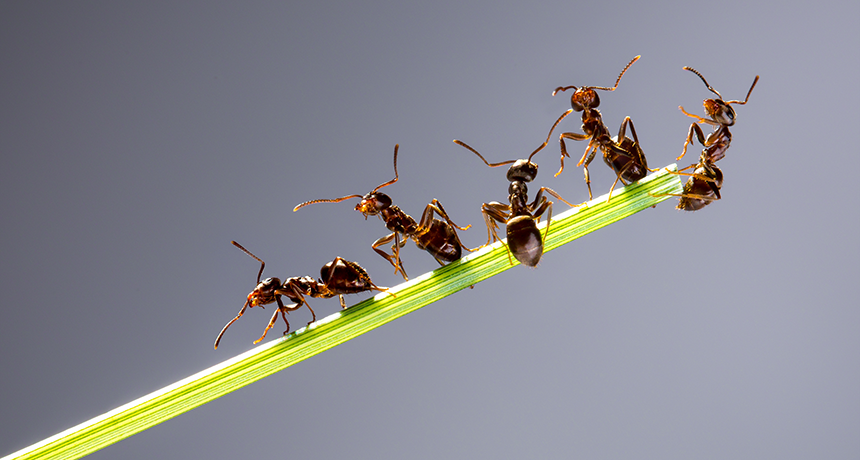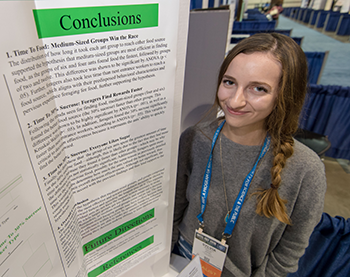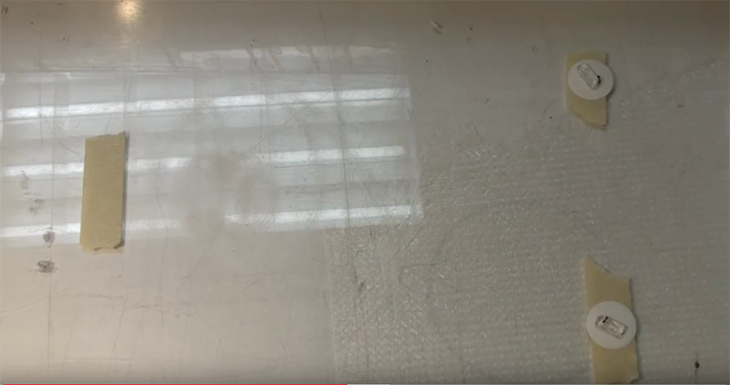How many ants is the best number of ants? More than one, fewer than 100
Ants make decisions faster in medium-size groups than in small or larger ones

How many ants does it take to forage efficiently? It’s not a joke. And the answer, one teen found, is roughly what you see here.
cookelma/istockphoto
Pittsburgh, Pa. — Two heads are better than one. After all, when trying to make decisions, it’s good to have a second opinion. But what about a third, fourth — even twelfth? What group size is best for making decisions quickly? For ants, four to six heads surpass one — and also outperform 12 or 24. That’s what Sylvia Zarnescu now reports.
The 18-year-old senior at Catalina Foothills High School in Tucson, Ariz., isn’t generally into ants. She’s interested in decision-making, especially by people. Those decisions could be simple, such as whether to eat food or to mate. Or they might be hard ones, such as where to go to college. “The processes involved just fascinate me,” she says.

Last summer, Sylvia read that social insects such as ants and bees can be used to model decision-making. Ants, for example, forage for food. When an ant finds it, it takes a bite and heads back to the nest. On the way, the ant leaves a scented trail for other ants to pick up. Back at the nest, the ant vomits up its meal into the mouths of other ants. Those nest-mates then decide with the first ant whether the barfed-up food was good enough to warrant a trip back for more. If it is, they follow the first ant’s scent trail to lunch.
When there are too few ants, it could take a long time for one ant to spread the word. If there are too many, it’s hard to “tell” each about the find. What’s the right number for foraging success? Sylvia decided to find out.
She contacted professors at the University of Arizona in Tucson. She was looking for someone who would let her study decision-making by ants in their lab. Wulfila Gronenberg studies how the brain controls behavior at the University of Arizona. He answered her email, she notes, and “was kind enough to take me.”
Working with Rebekah Keating — one of his graduate students — Sylvia set up an experiment. “I wanted to design a study that looked at intermediate-size groups,” she says. “Those are the ones you see [foraging] in the wild. You don’t see whole colonies go out to make every decision.”
Dorymyrmex bicolor is an ant that lives in warm desert areas of North and South America, including Arizona. Keating went out every week to a local anthill and brought some of these back for Sylvia to test. The teen tested the behavior of one, two, four, six, 12 and 24 ants. Each group was placed in a large box at a taped “starting line.” At the other end of the box were two food options.
What do you feed a hungry ant? They find sweetened gelatin delicious. “It’s like Jell-O for ants,” says Sylvia. “They’re little bricks of this [sugar] Jell-O.” But the bricks of gel weren’t equally sweet. One was only 3 percent sugar, the other 30 percent. Ants, the teen notes, have a sweet tooth. They should prefer the 30 percent gel.
Story continues below image.

Sylvia timed how long it took each group of ants to find the food. She also measured how much time they spent around each sweet treat. When there was just one or two ants, the discovery was slow. The same was true when she set 12 or 14 ants loose. But four to six ants? Perfect! These medium-size groups found the food fastest. They also figured out quickly that the sweetest food was best.
Sylvia also looked at how ants divvied up their jobs. Colonies have foraging ants and nest workers. In her tests, job training clearly mattered. The foragers were faster than the nest workers.
In the wild, the ants Sylvia studied forage in groups of four to six. Now she thinks she knows why: “These medium-sized groups are the best for decision-making.” With this number, she says, “the decision is spread optimally, so they’re able to make the most effective choices.”
Similar work has been done on bighorn sheep, fish and fruit flies, Sylvia notes. “It may not be four to six animals, but it’s the same principle,” she says. A medium size group “is optimal.”
So when faced with a new decision, two heads are better than one. But too many heads are too much. Like the ants, a good decision may just require a happy medium.
Sylvia brought her ant findings here, this past week, to the Intel International Science and Engineering Fair (ISEF). This yearly competition brought together almost 1,800 high school students from around the world to compete for almost $5 million in prizes. Created in 1950 by Society for Science & the Public, the Society still runs this competition. (The Society also publishes Science News for Students and this blog.) This year, Intel sponsored ISEF.
Update: This project won Sylvia a scholarship for tuition if she chooses to attend the University of Arizona.







